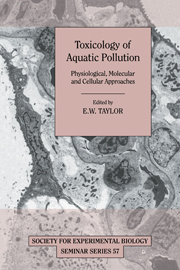Book contents
- Frontmatter
- Contents
- List of contributors
- Preface
- Water chemistry at the gill surfaces of fish and the uptake of xenobiotics
- Bioaccumulation of waterborne 1,2,4,5-tetrachlorobenzene in tissues of rainbow trout
- Dietary exposure to toxic metals in fish
- The physiology and toxicology of zinc in fish
- Lethal and sub-lethal effects of copper upon fish: a role for ammonia toxicity?
- The physiological status of brown trout exposed to aluminium in acidic soft waters
- Physiological and metabolic costs of acclimation to chronic sub-lethal acid and aluminium exposure in rainbow trout
- Physiological effects of nitrite in teleosts and crustaceans
- Metallothioneins in fish: induction and use in environmental monitoring
- Oestrogenic substances in the aquatic environment and their potential impact on animals, particularly fish
- Effect of genetic toxicants in aquatic organisms
- In vitro toxicology of aquatic pollutants: use of cultured fish cells
- Principles governing the use of cytochrome P4501A1 measurement as a pollution monitoring tool in the aquatic environment
- Index
In vitro toxicology of aquatic pollutants: use of cultured fish cells
Published online by Cambridge University Press: 20 May 2010
- Frontmatter
- Contents
- List of contributors
- Preface
- Water chemistry at the gill surfaces of fish and the uptake of xenobiotics
- Bioaccumulation of waterborne 1,2,4,5-tetrachlorobenzene in tissues of rainbow trout
- Dietary exposure to toxic metals in fish
- The physiology and toxicology of zinc in fish
- Lethal and sub-lethal effects of copper upon fish: a role for ammonia toxicity?
- The physiological status of brown trout exposed to aluminium in acidic soft waters
- Physiological and metabolic costs of acclimation to chronic sub-lethal acid and aluminium exposure in rainbow trout
- Physiological effects of nitrite in teleosts and crustaceans
- Metallothioneins in fish: induction and use in environmental monitoring
- Oestrogenic substances in the aquatic environment and their potential impact on animals, particularly fish
- Effect of genetic toxicants in aquatic organisms
- In vitro toxicology of aquatic pollutants: use of cultured fish cells
- Principles governing the use of cytochrome P4501A1 measurement as a pollution monitoring tool in the aquatic environment
- Index
Summary
Introduction
The human health disasters such as the severe abnormalities and fatalities due to consumption of Cd-contaminated rice (Itai-itai disease) and methyl-mercury contaminated shellfish (Minimata disease) in Japan, infantile liver cirrhosis from Cu-contaminated rice in India, the environmental contamination caused by the industrial accidents at Bhopal in India and Seveso in Italy (2,4,5-T and dioxin, respectively), as well as those in petroleum production and transport (platform blowouts in the Gulf of Mexico and North Sea, the wrecks of Exxon Valdez and Braer and the Gulf War), have raised awareness in the problems of environmental contamination by man's activities. Hundreds of new man-made chemicals are introduced into the environment each year and assessment of the potential impact of these xenobiotic (‘foreign to life’) contaminants on aquatic organisms is therefore being afforded a much higher priority than in past decades.
The effects of man-made contaminants are alarmingly widespread, one such example being the effects of polychlorinated biphenyls (PCBs). First produced in the 1920s, their chemical inertness, thermal conductivity and dielectric properties led to the use of around a million tonnes in electrical transformers and capacitors before it was realized that they could ‘switch on’ genes involved in generating carcinogenic compounds from polyaromatic hydrocarbons (PAHs) and that a combustion product, dioxin (also present as a contaminant of production) was one of the most toxic compounds known. They are no longer produced in significant amounts. However, they have been so pervasive that they have recently been identified, and their impact has been detected, in livers of fish from one of the oceans deepest abyssal plains.
- Type
- Chapter
- Information
- Toxicology of Aquatic PollutionPhysiological, Molecular and Cellular Approaches, pp. 253 - 266Publisher: Cambridge University PressPrint publication year: 1996
- 3
- Cited by



